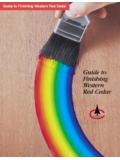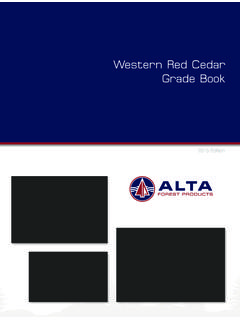Transcription of INSTALLING CEDAR SIDING - Specialty Wood
1 INSTALLING CEDAR SidingINSTALLINGCEDAR SIDING2 INSTALLING WESTERN RED CEDAR SIDINGC ongratulations on your choice of Western Red CEDAR SIDING . Western Red CEDAR is one of the world spremier quality woods noted for its appearance, light weight, insulation value and dimensional installed and finished, it will give years of trouble-free service and will give your home a character anddistinction that other sidings cannot has been an important building material for centuries. Its characteristics, like shrinking and swellingslightly in response to the moisture content of the air, are well known and building techniques have evolvedto mitigate their effects. Please read this brochure thoroughly it contains much useful information to makeyour relationship with Western Red CEDAR a long and happy brochure is organized into three sections. Section 1 deals with things you should know before you startinstalling Western Red CEDAR SIDING .
2 Section 2 describes installation techniques. Section 3 gives some helpfultips on INSTALLING CEDAR that these are general guidelines that may be followed with confidence in most areas. However, severelocal climatic conditions such as extreme heat, extreme dryness, high winds, seacoast exposure, and areas withwide climatic swings may necessitate additional fastening of the YOU STARTA cclimatize SIDING Before InstallingOne of the most stable softwoods,Western Red Cedaris nevertheless a natural material and it responds to theenvironment. CEDAR SIDING can swell or shrink as it gainsor loses moisture to reach equilibrium with the moisturecontent of the surrounding air. Ensuring that the moisturecontent of CEDAR SIDING is at equilibrium before it isinstalled will minimize movement later on. Recommendedmoisture content for sidings used in various regions of thecountry are given in Table the job site, keep the wood dry. Stack SIDING off theground and under cover.
3 If the wood is to be stored overdamp ground or new concrete, place a moisture barrierunder the SIDING . SIDING should be 4 to 6 in. above theground with air circulating freely around and throughoutthe stack. Acclimatization time varies with the moisturecontent of the SIDING . The following procedures aresuggested for different SIDING Dried ClearsThese have been dried at the mill to 12-15% moisturecontent. They are the most ready-to-use of all sidingproducts. If the SIDING has not been wetted prior toarrival on the job site it may be applied upon arrivalexcept in hot and dry conditions where 3 to 5 days ofwell ventilated storage is generally required. If the sidinghas been wetted it must be separated and allowed to drythoroughly before Knotty SidingsKnotty sidings are air or kiln dried to less than 19%moisture content. Stack the SIDING on evenly spaced,vertically aligned stickers (Figure 1) in a dry storage areafor 7-10 days.
4 More time may be required in damp orhumid (Unseasoned) SidingsUnseasoned or green sidings have not been dried priorto delivery and require a longer time to acclimatize thanseasoned sidings. Separate the SIDING with verticallyaligned stickers (Figure 1) and store in a well ventilateddry location for a minimum of 30 days, or longer in dampor humid conditions. If specifying unseasoned SIDING ,patterns such as channel, bevel and board-and-battenare recommended since these allow for widths are also recommended since thesemove less overall than wider Before InstallingAfter CEDAR has achieved equilibrium moisture con-tent and before it is installed, a coating on all surfaces(including ends) is recommended. The type of coatingwill vary with final finish selected. The coating protectsthe wood from water penetration, helps prevent stainingcaused by mildew and extractives and can increase theservice life of top coats.
5 The following coatings haveproven themselves in field testing (Table 2).Figure 1. SIDING Stacked with Vertically Aligned StickersTable 2. Recommended Priming Procedures forCedar SidingType ofRecommendedFinish CoatPriming CoatNatural and semi-Coat all surfaces with the staintransparent stainsSolid color stainsCoat all surfaces with anand paintsalkyd oil stain-blocking , use a clear waterrepellant on back of SIDING andthe primer on face and oilsCoat all surfaces with a coatof the bleaching oilTable 1. Recommended Moisture Content for SIDING InstallationDamp, WarmMost AreasDry, Southwest StatesSoutheastern Coastal AreasAverageIndividualAverageIndividualA verageIndividualPiecesPiecesPieces12%9-1 4%9%7-12%12%9-14%1. To calculate average, test 10% or more of Source:Wood Handbook YOU STARTN ails: Use Hot-Dipped Galvanized,Aluminum or Stainless SteelHot-dipped galvanized (as per ASTM153), aluminumand stainless steel fasteners are all corrosion-resistant andall can be used to fasten Western Red CEDAR .
6 Other typesof fasteners are not recommended. They can rust anddisintegrate and react adversely with the natural preserva-tive present in CEDAR resulting in stains and nails also react with CEDAR and should not be steel nails are the best choice, especially ifthe SIDING is to be finished with transparent or semi-transparent stain. Use No. 304 stainless for general sidingapplications and No. 316 for seacoast : Type, Size and SpacingFor best result use splitless SIDING nails. These havethin shanks and blunt points to reduce splitting. Forgreater holding power, nails with ring threaded or spiralthreaded shanks are suggested. Nails with textured headscan be used to reduce glossy spots at the nails whenfinishing (see Figure 2 for nail types).Nails should be driven with care. Heavy nailing distortsthe wood and may cause splitting. At mitered corners,near edges and near ends, nail holes may need to bepre-drilled to avoid size of nails to use depends on the type andthickness of SIDING .
7 Good building practice is to use nailslong enough to go through underlying materials, such assheathing and insulation, and penetrate at least 1-1/4 solid wood if using ring or spiral shank Table 3 for recommended nail lengths for variousthicknesses of should be fastened to each stud or furringstrip with nails spaced at a maximum of 24 in. placement depends on the SIDING pattern andwidth. The key is to fasten the SIDING securely withoutpreventing it from moving in response to the moisturecontent in the air. In general, each piece of SIDING mustbe nailed overlapping piecestogether restricts the natural movements of eachpiece and will cause 3. Minimum Recommended Nails Lengthsfor CEDAR SIDING Over Wood Sheathing (Nailed at Studs)* For application over foam sheathing, add the thickness ofthe foam to the tabulated nail ConstructionLike all SIDING materials, Western Red CEDAR performsbest when installed properly on a suitable frame.
8 Cedarsiding should be securely nailed to framing members,furring members or to blocking between framingmembers. Lumber sizes and spacing for blocking andfurring are shown in Table 4. Lumber Size and Spacing for Blocking and Furring** Furring must be securely fastened to studs.** Can be used in moist and severe climates to form an airspace between SIDING and SizeSpacing(in.)(in.)Blocking2x224 Furring over plywood/OSB sheathing**1x224 Furring overmasonry walls2x224 SidingSidingNail Type andType*ThicknessLength(in.)(in.)Ring orSpiral ShankBevel1/22 (6d)5/82 (6d)3/42-1/4 (7d)7/8 to3 (10d)15/165/43 (10d)rabbetedBoards,T&G and5/82 (6d)Channel3/42 (6d)7/82-1/4 (7d)Battens for Board3/43 (10d)and BattenFigure 2. Features of Recommended NailsShanksHeadsRingSpiralSidingTextured head5 BEFORE YOU STARTStud WallsStud walls generally require no special preparation forhorizontal SIDING installation. SIDING should be nailed intostuds at maximum 24 in.
9 Centers when applied over woodbased, solid sheathing and 16 in. on center when bevelsidings 11/16 or thinner are applied without those areas where an air space between SIDING andsheathing is desired, nail SIDING to furring strips (Table 4).Vertical SIDING applied to stud walls with or withoutsheathing requires horizontal nailers, blocking or otherwood framing members spaced not exceeding 24 center (Table 4). Check your local code to WallsMasonry walls require furring strips for horizontal andvertical SIDING installation. Furring strips must be thickenough to allow for nail penetration of 1-1/4 in. into solidwood with ring shank nail (Table 4).Applying SIDING Over Rigid Foam SheathingRigid foam sheathing has an insulation value superiorto that of traditional lumber and plywood , it has little or no nail holding power and usingrigid foam sheathing as a nailing base for CEDAR SIDING isnot recommended.
10 For best results with rigid foam andother sheathing products, follow the nailing recommen-dations given in this publication as to nail type,positioning, penetration and spacing. The footnote toTable 3 gives nail length recommendations for sidingapplied over rigid foam sheathing panels vary in moisture permeabilitybut are generally considered moisture barriers. Theyshould be used with a continuous film vapor retarder onthe inside wall under the interior finish. Rigid foamsheathing can cause moisture to accumulate on the backof SIDING and cause staining, buckling and damage tofinish coats. The following recommendations are meantto minimize potential problems when wood sidings areapplied over rigid foam sheathing: Use thicker SIDING patterns in widths of 8 in. or , narrow SIDING is more stable than thinner, widerpatterns and better able to resist dimensional changes.







